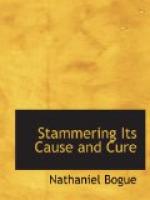One investigator shows that the diagnosis of “insanity” with later commitment to an asylum occurred in the case of a bad stutterer. When excited he would go through the most extreme contortions and the wildest gesticulations in a vain attempt to finally get all of the word out, finally pacing up and down the room like one truly insane. This tendency to believe that the stutterer is insane because of the convulsive or spasmodic effort accompanying his efforts to speak, is a mistaken one, although there can be little doubt of the tendency of this condition finally to lead to insanity if not checked.
HESITATION
Hesitation is marked by a silent, choking effort, often accompanied by a fruitless opening and closing of the mouth. Hesitation is a stage through which the sufferer usually passes before he reaches the condition known as Elementary Stammering.
STAMMERING
Stammering is a condition in which the person afflicted is unable to begin a word or a sentence no matter how much effort may be directed toward the attempt to speak, or how well they may know what they wish to say. In stammering, there is the “sticking” as the stammerer terms it, or the inability to express a sound. The difference between stammering and stuttering lies in the fact that in stuttering, the disorder manifests itself in loose and hurried (or in some cases, slow) repetitions of sounds, syllables or words, while in the case of stammering, the manifestation takes the form of an inability to express a sound, or to begin a word or a sentence.
Elementary stammering: This is the simplest form of this disorder. Here, the convulsive effort is not especially noticeable and the marked results of long-continued stammering are not apparent. Most cases pass quickly from the elementary stage unless checked in their incipiency.
Spasmodic stammering: This marks the stage of the disorder where the effort to speak brings about marked muscular contractions and pronounced spasmodic efforts, resulting in all sorts of facial contortions, grimaces and uncontrolled jerkings of the head, body and limbs.
Thought stammering: This, like Thought-Stuttering, is a form of Aphasia and manifests itself in the inability of the stammerer to think of what he wishes to say. In other words, the thought-stammerer, like the thought-stutterer, is unable to recall the mental images necessary to the production of a certain word or sound—and is, therefore, unable to produce sounds correctly. The manifestations described under Thought Stuttering are present in Thought Stammering also.
Combined stammering and stuttering: This is a compound form of difficulty in which the sufferer finds himself at times not only unable to utter a sound or begin a word or a sentence but also is found to repeat a sound or syllable several times before the following syllable can be uttered. Any case of stuttering or stammering in the Simple or Elementary Stages may pass into Combined Stammering and Stuttering without warning or without the knowledge, even, of the stammerer or stutterer.




